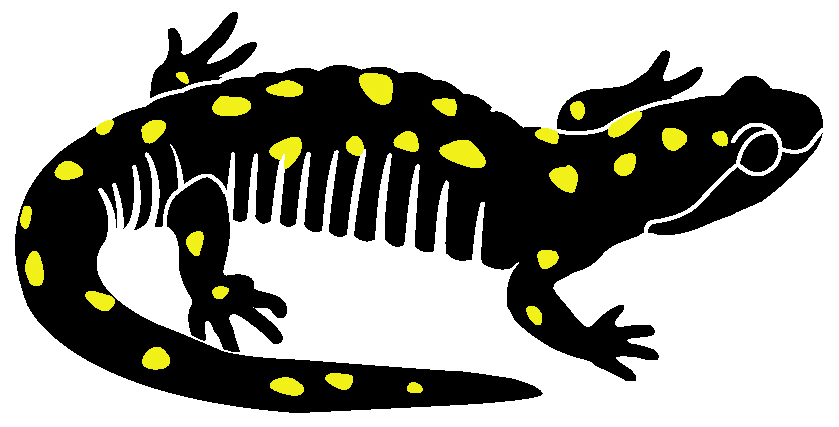Heading 1

The blue-spotted salamander, Ambystoma laterale, has a coloration reminiscent of old-time enamel ware.

Eggs are often laid in sheets on the pool floor. Pearly-white eggs are dead and are being consumed by a fungus.

Blue-spotted Salamander

Blue-spotted salamander eggs may also be attached to vegetation in small groups or dropped as single eggs on the pool bottom.

Blue-spotted larvae feed on zooplankton, insect larvae (e.g., the mosquito being eaten here) and other small organisms in the pool.

Eggs consist of (from the center) the embryo, the inner envelope, and the vitelline membrane, all of which are embedded in the clear matrix of the mass. Blue-spotted eggs can be distinguished from spotted eggs by the very small distance between the vitelline membrane and the inner envelope in the blue-spotted egg.
Adults
Blue-spotted salamanders (3-5.5") have a pattern of bright blue spots scattered over a black or grayish-black body. Hybrids of the blue-spotted salamander (see Jefferson/Blue-spot Complex) tend to be more brownish to gray-black in body color with less prominent blue spotting, most obvious on the sides.
Adults are fossorial and secretive. They are usually seen when crossing roads on migration nights, although they might also be encountered under cover objects in forested areas around vernal pools and forested wetlands. Be sure to replace any logs or other cover objects you might move exactly as you found them. These items provide important habitat for numerous organisms. They are found throughout eastern MA to the Connecticut River, but none has been reported from Cape Cod and the Islands.
Adults feed, usually nocturnally, on earthworms, slugs, isopods, and various other arthropods. Like all mole salamanders, they exude a sticky, white, noxious substance which is distasteful to some predators.
Eggs
Mating takes place in early spring at vernal pools when adults migrate from woodland burrows to their natal pool. A male will court a female, produce spermatophores and the female collects sperm from these in her cloaca. Between 100-500 eggs are strewn about the pool as either individual eggs, small clusters attached to vegetation, or sheets on the pool bottom. Individual eggs measure about .2" in diameter, are brown, have a vitelline membrane <.05" from the inner envelope of the egg, and are surrounded by a loose, clear gelatinous material. Individual masses may contain from 1-30 eggs.
Masses in hybrid populations (see Jefferson/Blue-spot Complex) are seldom laid in sheets, and tend to have a high percentage of gray to whitish eggs that have not been successfully fertilized scattered throughout the mass. Blue spotted egg masses do not have the “set gelatin” firmness of spotted salamander masses. Because the matrix of the mass is clear and the eggs are scattered throughout the pool, they can be very difficult to find.
Larvae
Larvae develop in the egg for about 3-4 weeks. Upon hatching, they have external gills just behind the head and a pair of balancers just forward of the gills. The balancers help to keep them upright until they develop legs shortly after hatching. Like other mole salamanders, blue-spotted salamander larvae develop for 2-4 months before they metamorphose into terrestrial juveniles.
Larvae feed on a variety of small organisms in the vernal pool from zooplankton to insects and even small vertebrates such as tadpoles. Their prey size increases as they grow. Mosquito larvae and pupa are a common prey item.
Larvae might be netted in a vernal pool, but larval mole salamanders are extremely difficult to distinguish from one another in the field. Short of genetic testing or raising it to metamorphosis, one can only guess at which Ambystoma species it is.
Blue=spotted Salamander is legally protected and listed as Special Concern pursuant to the Massachusetts Endangered Species Act (M.G.L. c. 131A) and implementing regulations (321 CMR 10.00).
As of January 2015, approximately 85 local populations had been documented among 61 towns since 1990.
Blue-spotted Salamander
Ambystoma laterale
For further information, consult the NHESP Fact Sheet for Blue-spotted Salamander.
Jefferson/Blue-spotted Salamander Complex
Throughout Massachusetts are found hybrid salamanders which have physical characteristics intermediate between Jefferson and blue-spotted salamanders. These hybrid animals are the result of historic crosses between the two parent species as long ago as the end of the last glaciation. Neither the origin of these hybrids nor the methods of their reproduction is fully understood. Most all of the hybrids are female and have extra sets of chromosomes making them polyploid animals. However, some of the hybrids are diploid having one set each of Jefferson and blue-spotted chromosomes.
Experienced researchers can sometimes identify the diploid hybrids as Jefferson or blue-spotted by the relatively wide head of the Jefferson or by the wider blue spots of the blue-spotted as well as other equally subtle characteristics. The polyploid specimens can only be accurately identified by blood analysis or karyotyping. The hybrids are assigned as either Jefferson or blue-spotted based on the parent species from which they have more sets of chromosomes or, if the values are equal, to coincide with the prevalent local species.
For field identification, if the hybrid is found west of the Connecticut River, it should be considered a Jefferson salamander. If it is found east of the Connecticut River, it should be considered a blue-spotted salamander.

Blue-spotted larvae are very difficult to distinguish from larvae of other mole salamanders in the field.

Recent metamorphs will gradually develop blue spotting.
